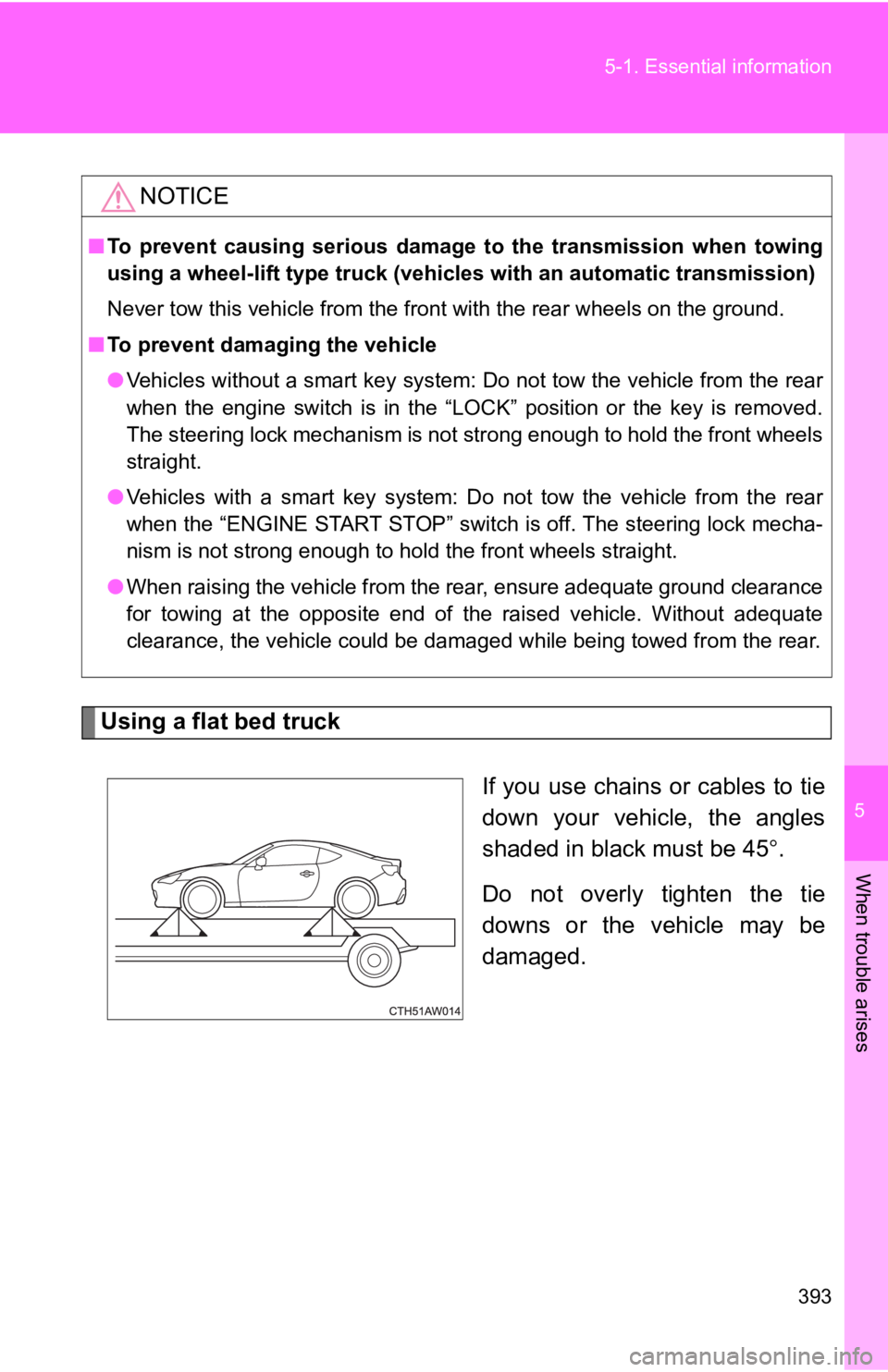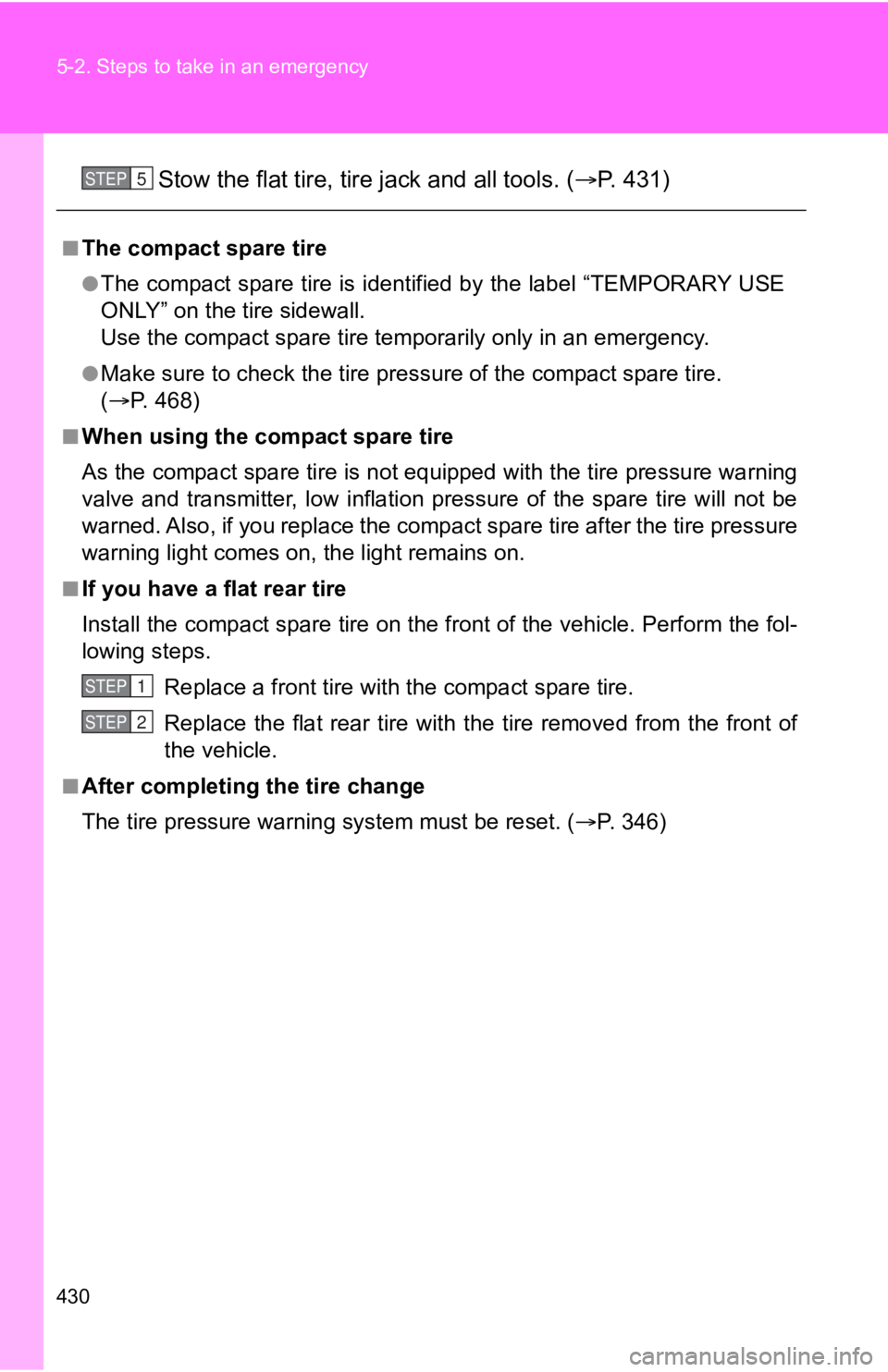Page 393 of 532

5
When trouble arises
393
5-1. Essential
information
Using a flat bed truck
If you use chains or cables to tie
down your vehicle, the angles
shaded in black must be 45.
Do not overly tighten the tie
downs or the vehicle may be
damaged.
NOTICE
■ To prevent causing serious damage to the transmission when towi ng
using a wheel-lift type truck (veh icles with an automatic transmission)
Never tow this vehicle from the front with the rear wheels on t he ground.
■ To prevent damaging the vehicle
●Vehicles without a smart key system: Do not tow the vehicle fro m the rear
when the engine switch is in the “LOCK” position or the key is removed.
The steering lock mechanism is not strong enough to hold the fr ont wheels
straight.
● Vehicles with a smart key system: Do not tow the vehicle from t he rear
when the “ENGINE START STOP” switch is off. The steering lock mecha-
nism is not strong enough to hold the front wheels straight.
● When raising the vehicle from the rear, ensure adequate ground clearance
for towing at the opposite end of the raised vehicle. Without a dequate
clearance, the vehicle could be damaged while being towed from the rear.
Page 425 of 532
5
When trouble arises
425
5-2. Steps to take in an emergency
If you have a flat tire
Your vehicle is equipped with a spare tire. The flat tire can be
replaced with the spare tire.
■ Before jacking up the vehicle
●Stop the vehicle in a safe place on a hard, flat surface.
● Set the parking brake.
● Shift the shift lever to P (vehicles with an automatic transmis -
sion) or R (vehicles with a manual transmission).
● Stop the engine.
● Turn on the emergency flashers. ( P. 3 8 4 )
■ Location of the spare t ire, jack and tools
*: Vehicles with a T145/70D 17 compact spare tire
Jack Jack handle
Spare tire
Towing eyelet
Screwdriver
Wheel nut
wrench
Spacer
*
Page 430 of 532

430 5-2. Steps to take in an emergency
Stow the flat tire, tire jack and all tools. (P. 431)
■The compact spare tire
●The compact spare tire is identified by the label “TEMPORARY US E
ONLY” on the tire sidewall.
Use the compact spare tire tem porarily only in an emergency.
●Make sure to check the tire pressure of the compact spare tire.
( P. 468)
■When using the compact spare tire
As the compact spare tire is not equipped with the tire pressure warning
valve and transmitter, low inflation pressure of the spare tire will not be
warned. Also, if you replace the compact spare tire after the t ire pressure
warning light comes on, the light remains on.
■If you have a flat rear tire
Install the compact spare tire on the front of the vehicle. Per form the fol-
lowing steps.
Replace a front tire with the compact spare tire.
Replace the flat rear tire with the tire removed from the front of
the vehicle.
■After completing the tire change
The tire pressure warning system must be reset. (P. 3 4 6 )
STEP 5
STEP 1
STEP 2
Page 431 of 532
5
When trouble arises
431
5-2. Steps to take in an emergency
■Storing a tire (for compact spare tire)
■Storing a tire (except
compact spare tire)
Vehicles with a T145/70D17 compact
spare tire only: Install the spare tire
spacer with the “Ft” mark facing the
front of the vehicle and the rear edge of
the spacer contacting the vehicle body.
Install the center fastener as shown in
the illustration.STEP 1
STEP 2
Vehicles with a T145/70D17 compact
spare tire only: Bef ore stowing the flat
tire, remove the s pare tire spacer.
Install the center fastener as shown in
the illustration.STEP 1
STEP 2
Page 435 of 532

5
When trouble arises
435
5-2. Steps to take in an emergency
NOTICE
■Do not drive the vehic
le with a flat tire.
Do not continue driving with a flat tire.
Driving even a short distance wi th a flat tire can damage the tire and the
wheel beyond repair.
■Be careful when driving over bumps with the compact spare tire
installed on the vehicle.
The vehicle becomes lower when d riving with the compact spare tire
compared to when driving with standard tires. Be careful when d riving
over uneven road surfaces.
■Driving with tire chains and the compact spare tire
Do not fit tire chains to the compact spare tire.
Tire chains may damage the vehicle body and adversely affect dr iving
performance.
■When replacing the tires
When removing or fitting the wheels, tires or the tire pressure warning
valve and transmitter, contact yo ur Toyota dealer as the tire pressure
warning valve and transmitter may be damaged if n ot handled correctly.
■To avoid damage to the tire pressure warning valves and transmi t-
ters
When a tire is repaired with liquid sealants, the tire pressure warning
valve and transmitter may not operate properly. If a liquid sea lant is
used, contact your Toyota dealer or other qualified service shop as soon
as possible. Make sure to replace the tire pressure warning val ve and
transmitter when replacing the tire. ( P. 3 4 6 )
■Stowing the jack
When stowing the jack in the jack holder, make sure that the pa rt that the
jack handle attaches to is pointing towards the inside of the t runk. Failure
to do so may damage the vehicle body.
■Replacing a flat tire
Do not hit and bend the disc rotor backing plate when removing and
installing the tire. A bent backi ng plate may scrape against th e disc rotor
and cause noise while the vehicle is in motion.
Page 449 of 532
5
When trouble arises
449
5-2. Steps to take in an emergency
NOTICE
■
When handling jumper cables
Be careful that the jumper cables do not become tangled in the cooling fans
or any of the belts when connecting or disconnecting them.
■ When closing the doors
While pushing the door glass towards the inside of the vehicle, slowly close
the door.
Because the side window open/close function linked to door oper ation will
not operate, the window may interfere with the vehicle body, po ssibly
scratching both the vehicle body and window, or even shattering the window.
Page 454 of 532
454 5-2. Steps to take in an emergency
WARNING
■When attempting to free a stuck vehicle
If you choose to push the vehicle back and forth to free it, ma ke sure the sur-
rounding area is clear to avoid striking other vehicles, object s or people. The
vehicle may also lunge forward or lunge back suddenly as it bec omes free.
Use extreme caution.
■ When shifting the shift lever
For vehicles with an automatic transmission, be careful not to shift the shift
lever with the accelerator pedal depressed.
This may lead to unexpected rapid acceleration of the vehicle t hat may
cause an accident resulting in death or serious injury.
NOTICE
■ To avoid damage to the trans mission and other components
● Avoid spinning the rear wheels and depressing the accelerator p edal more
than necessary.
● If the vehicle remains stuck even after these procedures are performed,
the vehicle may require towing to be freed.
Page 523 of 532

523
Alphabetical index
Dimension ................................ 458
Dinghy towing ......................... 266
Display
Drive information .................. 210
Multi-information display ........................ 200, 207
Trip information ............ 202, 208
Warning messages............... 408
Do-it-yourself maintenance .... 324
Doors Door lock .................... 25, 38, 43
Door windows ......................... 72
Side mirrors ............................ 69
Driver's seat belt
reminder light ........................ 400
Driving Break-in tips ......................... 155
Correct posture....................... 87
Procedures ........................... 152
Winter drive tips.................... 261
Electric power steering........... 245
Electronic key If the electronic key does not operate properly ........... 441
Emergency flashers Switch ................................... 384
Emergency, in case of
If the electronic key does not operate properly ........... 441
If the engine will not start...... 436
If the shift lever cannot
be shifted from P ................ 439
If the vehicle has a
discharged battery ............. 445
If the warning buzzer sounds ............................... 396
If the warning light turns on .............................. 396 If the warning message
is displayed .........................408
If you have a flat tire .............425
If you lose your keys .............440
If you think something is wrong ..................................394
If your vehicle becomes stuck ...................................453
If your vehicle has to be stopped in an
emergency ..........................455
If your vehicle needs to be towed .............................386
If your vehicle overheats .......450
Engine Compartment ........................331
Engine switch ................166, 175
Hood......................................327
How to start the engine .........................166, 175
Identification number .............459
If the engine will not start ......436
Ignition switch................166, 175
Overheating...........................450
Engine coolant Capacity ................................464
Checking ...............................335
Engine coolant temperature gauge ......................................191
Engine immobilizer system.......79
Engine oil Capacity ................................462
Checking ...............................332
Preparing and checking before winter .......................261
Engine switch ...................166, 175
Engine switch light ..................289
EPS ............................................245
Event data recorder ...................18
E